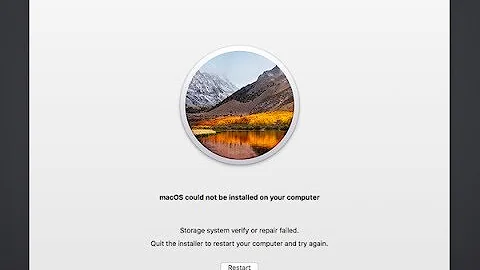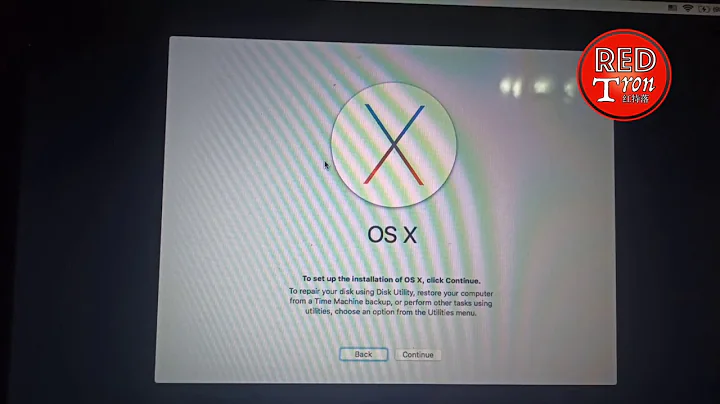Re-install Mac OS X: "Mac OS X cannot be installed on this computer."
Solution 1
I'm not sure whether there was an update in the installation discs between 2007 and 2008, when I bought my computer.
Even if I knew a way to use another version's install media ... which I do not ... posting the info here would not be allowed since I'm sure it's a violation of something somewhere.
If you got this MacBook new in August of 2008 then guessing from the MacBooks listed on everymac.com for 2008, you apparently have an early 2008 MacBook. So, yes, it is possible that your MacBook requires updates included in a later version of Leopard than your friends 2007 MacBook required.
Another (remote) possibility is to call a local Apple store and see if they would help you out with the reinstall. I tend to doubt that they would, but it never hurts to ask, perhaps?
What I would suggest is that if you really need to install OS X to your MacBook then pop down to a retail store and fork over the $30 to $40 for a Snow Leopard "upgrade" retail disc and install that. FWIW, IMO upgrading to Snow Leopard is worth doing in any case. Especially when it costs so little to do it.
- Note: If what you want to use is one of the iLife applications not just OS X, then the Snow Leopard retail disc won't help you. The retail install disc only includes OS X and X Code support. The iLife application suite included on the install media which comes with a MacBook is separate retail product from the OS X retail install disc.
Do not be put off by the word "upgrade" in the description of the Snow Leopard retail disc. Apple's upgrade is not like a MS upgrade. While the license agreement for that install only allows you to upgrade from Leopard, the technical truth is that it is a complete install disc.
You can upgrade an existing installation or install to a bare hard drive. You can use it not only to upgrade from Leopard but also from Tiger. (Or at least that's what I've read).
One caveat. If you decide to get a Snow Leopard retail disc try to get the latest version you can. This is probably 10.6.3. While you don't need it to install, it will save you some time because you won't have as much to download to update the OS after the install.
It occurred to me after posting the stuff above that if you are willing to risk it, another approach you might try is to boot your MacBook in target disk mode, connect it to your friend's MacBook using a firewire cable, and use your friend's install media in his MacBook to install OS X onto your MacBook's hard drive.
If this works then you might also also need to also use your friend's MacBook to update the installation to the latest (or at least a later) version of Leopard. Again, I just don't know if his version of Leopard will run without problems on your MacBook.
I frankly have no idea if any of this would work or not. But if you are careful it shouldn't hurt anything (much ... apparently your OS X install is already toast?) to try. Your call.
Taking the above yet one step further and, as always, if you and your friend can agree on it, you could simply temporarily move your MacBook's hard drive into your friend's MacBook. (I'm pretty sure the 2007 MacBook also uses a SATA hard drive).
Then just use his install media in his 2007 MacBook to install Leopard to your drive. Then update the install to the latest (or at least a later) version of Leopard. Then move it back to your 2008 MacBook. It seems like this should work, no?
Or you could use an external drive enclosure for your hard drive together with your friend's MacBook. This should also work. I've installed Leopard to an external USB attached hard drive using my early 2008 MacBook. I would expect it to work with a 2007 MacBook as well.
But Target Disk Mode would seem to be easiest way to go, if it works, since you don't have to track down the proper screw drivers and remove/replace any hard drives. I've never tried installing to a Mac in Target Disk Mode though so I can't offer more than the suggestion.
Solution 2
First, I have to bust a myth. The Mac OS X install or restore discs that come with a given Mac are ABSOLUTELY NOT machine-locked. It's actually the other way around; the Mac hardware is OS-locked. That is, the firmware of a given Mac tells the Mac OS X system software installer what minimum version of Mac OS X that particular Mac requires. You can take the install discs from a brand-new Mac and use them to install Mac OS X on any earlier Mac, but not the other way around.
The reason for this is that, in order to work properly and reliably, your MacBook's built-in I/O devices and over chips require later drivers than the ones that were included in earlier releases of Mac OS X. The MacBook you bought in August of 2008 would've shipped with Mac OS X "Leopard" v10.5.2, but not just any build of 10.5.2, either; specifically build 9C2015, or possibly a later build. Any set of Leopard install disks containing 10.5.3 or later would be expected to include the required driver versions, and thus would be allowed to install. But any Leopard install disks containing any build earlier than 10.5.2 9C2015 would be rejected.
If you had a retail box version Leopard install discs handy, they could be 10.5(.0), 10.5.1, 10.5.4, or 10.5.6, because Apple periodically updated the version of Leopard in the retail box. If your Leopard retail box contained 10.5 or 10.5.1, it wouldn't install on your Early 2008 MacBook. If it contained 10.5.4 or 10.5.6, it would work.
I concur with the other suggestions of paying $29 for the Snow Leopard "upgrade" discs. It's actually a full install of 10.6.x, not just an updater. It's called an "upgrade" because the terms of the license require you to already own a license to 10.5.x, which you do, because 10.5.2 came with your MacBook.
Related videos on Youtube
Josh Leitzel
Ruby ± Rails, JavaScript | CoffeeScript | Angular I can be contacted at [email protected]. Twitter GitHub Blog
Updated on September 17, 2022Comments
-
Josh Leitzel over 1 year
I'm trying to do a fresh install of Mac OS X on my MacBook. When I try to do so, I get the error "Mac OS X cannot be installed on this computer." I've searched the problem and discovered that the computer is very particular about which installation discs are used (that is, it must be the same model/year installation disk that came with the computer). I am away from home right now and do not have my install discs with me, so I borrowed a friend's. What I'm wondering is if it will be possible to re-install using his discs.
Some specifics: I bought my MacBook in August of 2008. It is currently version 10.5.8. My friend's discs are copyrighted to 2007. This is the reason I'm unsure of whether this can work. I think that I am able to use any installation discs that are as old or newer than my computer's original installation discs, but I'm not sure if these are or not. (That is to say, I'm not sure whether there was an update in the installation discs between 2007 and 2008, when I bought my computer.) Can anyone shed some light on this issue?
Also, do I need to erase my hard drive before trying to re-install? I want a completely fresh install, and I've already made the appropriate backups. But I was under the impression that the installer would wipe everything for me. Is that correct?
-
ghoppe almost 14 yearsAgreed, spring for the $30 to get Snow Leopard, a nice inexpensive update, and install disks that are not machine-locked.
-
Josh Leitzel almost 14 yearsThanks for all the great information! I'll probably just grab the Snow Leopard disc.
-
Gordon Davisson almost 14 yearsActually, some OS X discs are machine-locked -- specifically, if they include the OS and also the bundled software sold with a particular model, they'll be locked to that model. OS-only discs, on the other hand, will generally work on any older model (with a few exceptions, like IIRC some builds of 10.4.x that only worked on Santa Rosa chipset models...)
-
benc almost 13 yearsI don't know if your assertion about machine locking is true, but I can assure you that some CPU-bundled disks are not forward compatible with every CPU that supports that release. It's called "not forward compatible to something that doesn't exist yet". I don't think Apple deliberately breaks forward compatibility in the product, so sometimes it might work, but you should only install with the disks that came with the computer or NEWER retail releases.
-
Spiff almost 13 years@benc "Not forward compatible" is what I described in the rest of my Answer. The big myth I was trying to bust is the notion that the OS install DVDs that come with Macs are not backward-compatible. They are backward-compatible to other Mac systems that shipped earlier and support the same major OS version (e.g. all existing machines that support Snow Leopard).



![[Resolved]No Packages Were Eligible for install in Apple MAC OS X error](https://i.ytimg.com/vi/VHJRPV_usKU/hq720.jpg?sqp=-oaymwEcCNAFEJQDSFXyq4qpAw4IARUAAIhCGAFwAcABBg==&rs=AOn4CLBfpWxfA1BDDyAaiZ4-qb8qy2rYgQ)
